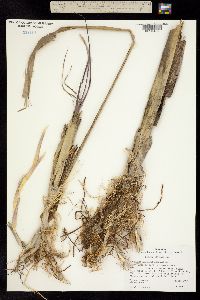Spartina alterniflora
|
|
|
|
Family: Poaceae
Smooth Cordgrass, more...Spartine Alterniflore
[Dactylis fasciculata C. Sm., moreSpartina alterniflora var. glabra Fernald, Spartina alterniflora var. pilosa (Merr.) Fernald, Spartina brasiliensis Raddi, Spartina glabra , Spartina glabra var. alterniflora (Loisel.) Merr., Spartina glabra var. pilosa Merr., Spartina laevigata Bosc ex Link, Spartina maritima var. alterniflora (Loisel.) St.-Yves, Spartina maritima var. brasiliensis (Raddi) St.-Yves, Spartina maritima var. glabra (Muhl. ex Elliott) St.-Yves, Spartina merrillii , Spartina stricta var. alterniflora (Loisel.) A.Gray, Spartina stricta var. glabra (Muhl. ex Elliott) A. Gray, Spartina stricta var. maritima (Walter) Scribn.] |
Plants rhizomatous; rhizomes elongate, flaccid, white, scales inflated, not or only slightly imbricate. Culms to 250 cm tall, (0.3)5-15(20) mm thick, erect, solitary or in small clumps, succulent, glabrous, having an unpleasant, sulphurous odor when fresh. Sheaths mostly glabrous, throat glabrous or minutely pilose, lower sheaths often wrinkled; ligules 1-2 mm; blades to 60 cm long, 3-25 mm wide, lower blades shorter than those above, usually flat basally, becoming involute distally, abaxial surfaces glabrous, adaxial surfaces glabrous or sparsely pilose, margins usually smooth, sometimes slightly scabrous, apices attenuate. Panicles 10-40 cm, with 3-25 branches, often partially enclosed in the uppermost sheath; branches 5-15 cm, loosely appressed, not twisted, more or less equally subremote to moderately imbricate throughout the panicle, axes often prolonged beyond the distal spikelets, with 10-30 spikelets. Spikelets 8-14 mm, straight, usually divergent, more or less equally imbricate on all the branches. Glumes straight, sides usually glabrous, sometimes pilose near the base or appressed pubescent, hairs to 0.3 mm; lower glumes 4-10 mm, acute; upper glumes 8-14 mm, keels glabrous, lateral veins not present, apices acuminate to obtuse, occasionally apiculate; lemmas glabrous or sparsely pilose, apices usually acuminate; paleas slightly exceeding the lemmas, thin, papery, apices obtuse or rounded; anthers 3-6 mm. 2n = 62 [56, 70]. Spartina alterniflora is found on muddy banks, usually of the intertidal zone, in eastern North and South America, but it is not known from Central America. In addition, it has become established on the west coast of North America, England, southeastern France, and China. It hybridizes with S. maritima in Europe, with S. pectinata in Massachusetts, and with S. foliosa in California. The rhizomes and scales of S. alterniflora have large air spaces, presumably an adaptation to the anaerobic soils of its usual habitat. Decaploid plants tend to be larger than octoploids, but they cannot be reliably distinguished without a chromosome count. Spartina alterniflora is considered a serious threat to coastal ecosystems in Washington and California. It out-competes many of the native species in these habitats and frequently invades mud flats and channels, converting them to marshlands. Pure S. alterniflora grows within the lower elevational marsh zones in its native range but, in San Francisco Bay, its hybrids with S. foliosa grow both below and above the range of that species. Culms coarse, soft and fleshy, to 3 m, or in the north as low as 3 dm, sulfurously malodorous when bruised, rhizomes elongate, thick and soft, the closely imbricate scales inflated; lvs elongate, 5-15 mm wide, glabrous or nearly so; panicle narrow, 1-3 dm; spikes slender, appressed to the axis, 5-10 cm; spikelets scarcely imbricate, erect or nearly so, those on one side of the spike usually 3-8 mm apart; rachis prolonged beyond the uppermost spikelet and usually conspicuously exceeding it; spikelets glabrous or somewhat hairy; first glume linear, half to nearly as long as the lemma; second glume 10-14 mm, exceeding the lemma, its midvein scarcely or not at all prolonged beyond the thin margins; 2n=42, 56, 70. Coastal salt-marshes, mainly intertidal, smaller at the upper tidal margins; Que. and Nf. to Fla. and Tex.; also on the Atlantic coast of S. Amer. and in n. Europe. Gleason, Henry A. & Cronquist, Arthur J. 1991. Manual of vascular plants of northeastern United States and adjacent Canada. lxxv + 910 pp. ©The New York Botanical Garden. All rights reserved. Used by permission. |

















































































